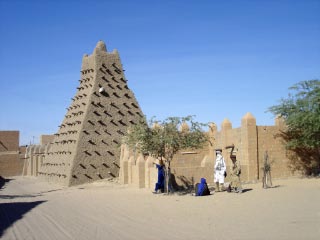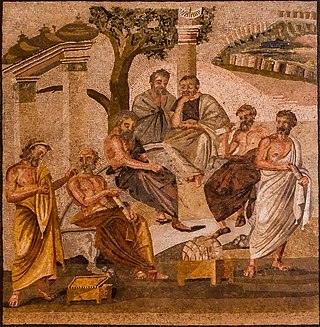
Year 1100 (MC) was a leap year starting on Sunday of the Julian calendar, the 1100th year of the Common Era (CE) and Anno Domini (AD) designations, the 100th year of the 2nd millennium, the 100th and last year of the 11th century, and the 1st year of the 1100s decade. In the proleptic Gregorian calendar, it was a non-leap century year starting on Monday.

Year 989 (CMLXXXIX) was a common year starting on Tuesday of the Julian calendar.

Mansa Musa was the ninth mansa of the Mali Empire, which reached its territorial peak during his reign. Musa is known for his wealth and generosity. He has been subject to popular claims that he is the wealthiest person in history, but his actual wealth is not known with any certainty. His riches came from the mining of significant gold and salt deposits in the Mali Empire, along with the slave and ivory trade.

Timbuktu is a city in Mali, situated twenty kilometres (12 mi) north of the Niger River. The town is the capital of the Tombouctou Region, one of the eight administrative regions of Mali and one town of Songhai people. It had a population of 54,453 in the 2009 census.

The Songhai Empire was a state that dominated the western Sahel/Sudan in the 15th and 16th century. At its peak, it was one of the largest states in African history. The state is known by its historiographical name, derived from its leading ethnic group and ruling elite, the Songhai. Sonni Ali established Gao as the capital of the empire although a Songhai state had existed in and around Gao since the 11th century. Other important cities in the empire were Timbuktu and Djenné, conquered in 1468 and 1475 respectively, where urban-centered trade flourished and to the south is the north Akan state of Bonoman. Initially, the empire was ruled by the Sonni dynasty, but it was later replaced by the Askia dynasty (1493–1901).

Sudano-Sahelian architecture refers to a range of similar indigenous architectural styles common to the African peoples of the Sahel and Sudanian grassland (geographical) regions of West Africa, south of the Sahara, but north of the fertile forest regions of the coast.

Sunni Ali, also known as Si Ali, Sunni Ali Ber, was born in Ali Kolon. He reigned from about 1464 to 1492. Sunni Ali was the first king of the Songhai Empire, located in Africa and the 15th ruler of the Sunni dynasty. Under Sunni Ali's command, many cities were captured and then fortified, such as Timbuktu and Djenné. Sunni conducted a repressive policy against the scholars of Timbuktu, especially those of the Sankore region who were associated with the Tuareg whom Ali expelled to gain control of the town.

Sankoré Madrasa is one of three ancient centers of learning located in Timbuktu, Mali. It is believed to be established by Mansa Musa, who was the ruler of the Mali Empire, though the Sankoré mosque itself was founded by an unknown Malinke patron. The three mosques of Sankoré: Sankoré, Djinguereber, and Sidi Yahya comprise the University of Timbuktu. The madrasa went through multiple periods of patronage and renovation under both the Mali Empire and the Songhai Empire until the Battle of Tondibi in 1591 led to its looting. Madrasa (مدرسة) means school/university in Arabic and also in other languages that have been influenced by Islam.

The Sidi Yahya Mosque, also known as the Mosque of Muhammad-n-Allah, is a mosque and madrasa of Timbuktu in Mali. The construction of the mosque began in 1400 under the leadership of Sheikh el-Mokhtar Hamalla of Timbuktu and was finished in 1440.

Timbuktu Manuscripts is a blanket term for the large number of historically significant manuscripts that have been preserved for centuries in private households in Timbuktu, a city in northern Mali. The collections include manuscripts about art, medicine, philosophy, and science, as well as copies of the Quran. The number of manuscripts in the collections has been estimated as high as 700,000.
Qadial-Aqib ibn Mahmud ibn Umar ibn Muhammad Aqit was a Sanhaja Berber qadi of Timbuktu and Imam of Sankore mosque.
Mohammed Bagayogo Es Sudane Al Wangari Al Timbukti was an eminent scholar from Timbuktu, Mali. He was the Sheik and professor of highly esteemed scholar, Ahmed Baba and teacher at the Sankore Madrasah, one of three philosophical schools in Mali during West Africa's golden age ; the other two were Sidi Yahya Mosque and Djinguereber Mosque. He was born in Djenné in 1523. A significant amount of his writing has been preserved in manuscript form at the Ahmed Baba Institute, a repository for African literature. Some of the manuscripts found their way into French museums. A project is under way to digitalise these manuscripts which will lead to better understanding of the culture that flourished in Mali in the medieval period.
The University of Timbuktu is a collective term for the teaching associated with three mosques in the city of Timbuktu in what is now Mali: the mosques of Sankore, Djinguereber, and Sidi Yahya. It was an organized scholastic community that endured for many centuries during the medieval period. The university contributed to the modern understanding of Islamic and academic studies in West Africa during the medieval period and produced a number of scholars and manuscripts taught under the Maliki school of thought.

Tourism in Mali is not well developed. Due to issues with infrastructure, tourism had been slow to grow but had seen improvements prior to the 2002 Africa Cup of Nations. However, due to the Northern Mali conflict and threats from terrorism, all major tour operators have withdrawn services which saw a decrease in tourists from 200,000 in 2011 to 10,000 the following year. The nation has four UNESCO World Heritage Sites, including Timbuktu.

A variety of ancient higher-learning institutions were developed in many cultures to provide institutional frameworks for scholarly activities. These ancient centres were sponsored and overseen by courts; by religious institutions, which sponsored cathedral schools, monastic schools, and madrasas; by scientific institutions, such as museums, hospitals, and observatories; and by respective scholars. They are to be distinguished from the Western-style university, an autonomous organization of scholars that originated in medieval Europe and has been adopted in other regions in modern times.
Sidi Mahmoud Ben Amar was a revered Muslim scholar who is one of the 333 Sufi saints said to be buried in Timbuktu. The tomb of Sidi Mahmoud Ben Amar is among 16 cemeteries and mausolea that are a part of Timbuktu, which is classified as a UNESCO World Heritage Site. On 30 June 2012, it was reported that his tomb had been destroyed by Ansar Dine following the Battle of Gao, as it contravened sharia according to Ansar Dine. These attacks resemble those carried out by the Wahabist movement on the Arabian peninsula during the late 18th century.

Albert Félix Dubois was a French journalist, explorer and entrepreneur who is best known for his books about his travels in French West Africa.

Starting out as a seasonal settlement, Timbuktu in Mali became a permanent settlement early in the 12th century. After a shift in trading routes, the town flourished from the trade in salt, gold, ivory and slaves from several towns and states such as Begho of Bonoman, Sijilmassa, and other Saharan cities. It became part of the Mali Empire early in the 14th century. By this time it had become a major centre of learning in the area. In the first half of the 15th century the Tuareg tribes took control of the city for a short period until the expanding Songhai Empire absorbed the city in 1468. A Moroccan army defeated the Songhai in 1591, and made Timbuktu, rather than Gao, their capital.

The architecture of Mali is a distinct subset of Sudano-Sahelian architecture indigenous to West Africa. It comprises adobe buildings such as the Great Mosque of Djenné or the University of Timbuktu. It can be found all over the Sahel region of Africa. Malian architecture developed during the Ghana Empire, which founded most of Mali's great cities. They then flourished in West Africa's two greatest civilisations the Mali Empire and the Songhai Empire.














